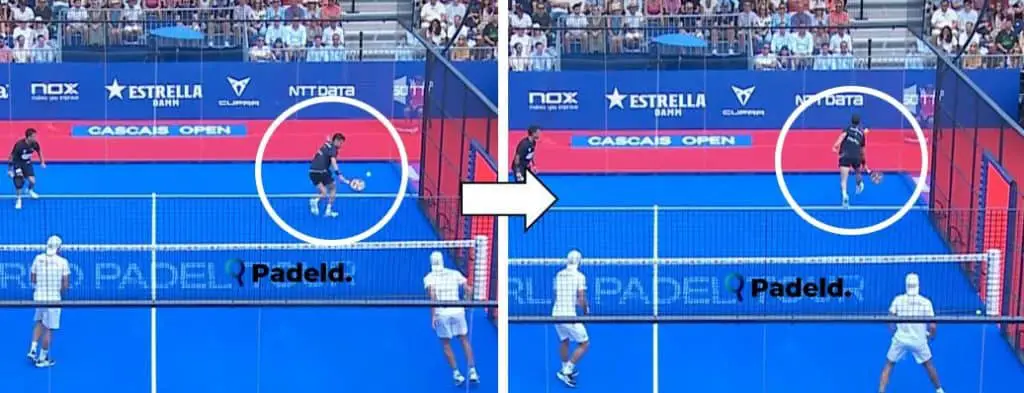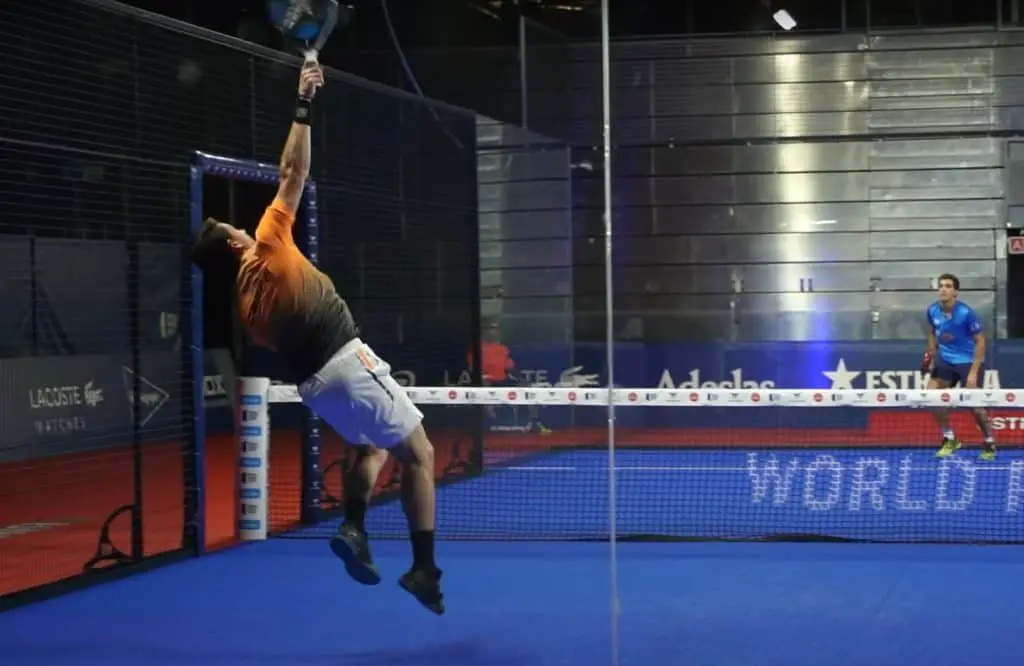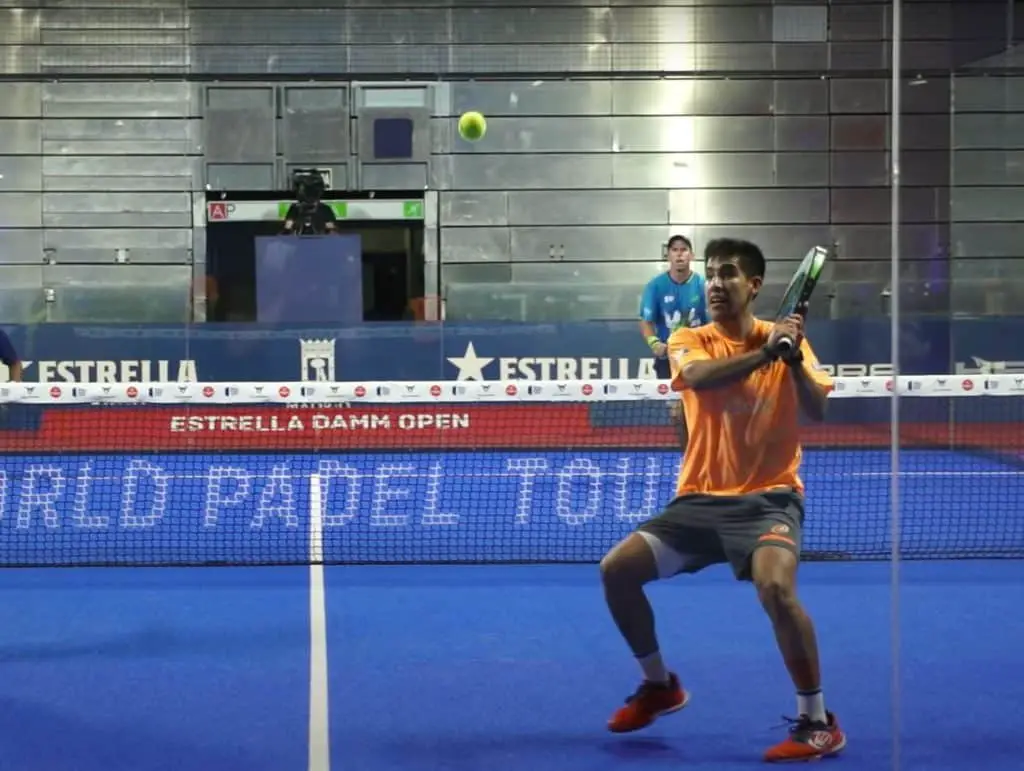One of the things that makes padel such an interesting game to play is the design of the court and how the ball interacts with the various installations. If you’ve ever watched the sport, you’ll probably be aware that the entire court is surrounded by a cage-like enclosure that is made out of glass in some places, and metallic fencing in others.
In my experience, the first questions that padel newcomers usually ask are related to the walls of the court! They want to know if the ball is allowed to hit the walls, when it is allowed to hit them, and what happens if it does. If the ball strikes the back wall, does the person who hit the ball automatically lose the point? If you’re on the receiving end of a shot, should you allow the ball to hit the back wall, and what are the advantages of doing so? These are all questions that I’ll be aiming to answer for you in this post.
So, can the ball hit the back wall in padel?
Yes, the ball is allowed to hit the back wall in padel, as long as it bounces on the ground first. For example, if a player hits a shot to their opponent’s side of the court and it hits the back wall without bouncing on the ground beforehand, the player who hit the shot will lose the point.
In padel you are also permitted to hit the ball into the glass part of your own back wall in order to continue a rally. For example, imagine you are taking part in a rally and your opponent gets the ball past you with a well-placed shot to your right. The ball hits the ground, and then bounces off the back wall as you run towards it to try to hit it. At this point, you are running towards the back wall, so it’s incredibly hard to hit a conventional shot back over the net before the ball bounces on the ground for a second time (which would cause you to lose the point). In this scenario, your only real option is to hit the ball into the glass on your own back wall with enough force that it causes it to rebound and travel over the net, back onto your opponent’s side of the court. This is a perfectly legal strategy in padel and is one that you’ll see professional players use all the time when they’re out of position.

Padel courts have a lot of walls, so if you’re not sure what the back wall is, it is the large wall that is positioned parallel to the net and perpendicular to the side walls. The diagram below should make it a little clearer! There are two of them on a padel court, and they are usually 10 metres wide and 4 metres in height. The lowest 3 metres of the wall is made from transparent glass, and the top metre of the wall is made of a metallic fence-like material.

So, if you’re ever planning to hit a powerful shot towards the back of your opponent’s court, you need to make sure that the ball touches the ground on their side of the court before it makes contact with the back wall. If you fail to do this, the point will end immediately, and it will be awarded to your opponent. If you do this successfully, the point will continue, and your opponent will need to find a way to return the ball.
How Do Professional Padel Players Use The Back Wall?
If you watch a professional game of padel, you’ll quickly see that these players are experts in using the back wall to their advantage. The back wall can be used in an attacking way as well as a defensive way, and I’ll detail some of the methods below.
Attacking Methods
Firstly, let’s look at an attacking use of the back wall. Attacking uses occur most often when you and your partner are in full control of the point. Usually, the team in control will have pushed themselves up towards the net and will be commanding the centre of the court. When you get yourselves in this position, you should be looking for any opportunity to get your opponents off balance and win the point. A great way to do this is by hitting the ball into the back wall at awkward angles.
For example, if you find yourself on the right-hand side of the court, you should try and hit across the court towards the left whilst targeting the back wall. It’s much harder for your opponent to judge how the ball will rebound from the back wall when that rebound is occurring at a sharp angle. If you just hit the ball straight down the line down the right hand side of the court, it will be much easier for your opponents to judge the ball as it rebounds from the glass.
I’d also recommend trying to get the ball to bounce as close to the back wall as possible. This means that the bounce on the ground and the rebound off the wall will occur within less than a second of each other, giving your opponents less time to react to the shot/rebound. If you hit the ball and it bounces 5 metres away from the back wall, not only will the ball be travelling much slower by the time it reaches the wall, but your opponents will have much more time to track the flight path of the ball and get themselves in a good position to return it.
Lastly, one of the most common uses of the back wall in an attacking sense is during the smash shot. A well-executed smash shot that hits the opponent’s back wall can instantly win you a point, so it’s definitely something that’s worth practicing! Basically, if the opponent hits the ball up in the air and you get the opportunity to play the smash from the middle of the court, you should hit the ball as hard as possible into the ground, about a metre from the opponent’s back wall. If you’ve played the shot with enough power, the ball will hit the ground, then the back wall, and will bounce high above your opponent’s heads until it gets back to your side of the court. The goal here is to hit the ball hard enough that it goes too high for your opponents to reach, and thus wins you the point.

Defensive Methods
When the opponent hits a powerful shot towards you, sometimes it is a much better strategy to allow the ball to bounce off the back wall before you return it. By letting the ball hit the back wall, you will allow the ball to slow down significantly and therefore you will give yourself more time to plan and execute your shot. If you don’t use the back wall, this would force you to hit your return shot very quickly, often on the volley! This is a much harder shot to execute and can lead to a lot of lost points.
One of the main aspects of becoming comfortable playing padel is getting used to using the back wall, rather than just trying to hit the ball instantly. The more matches you play and the more you practice, the better you will become at judging where the ball is going to end up after it hits the wall, and as a result you’ll be able to get yourself in much better positions to hit your shots.

When Should You Let The Ball Hit The Back Wall?
I’ve already briefly covered this above, but I thought I would just write a short section about when you should allow the ball to hit the back wall on your side of the court. The scenarios below are when most players will choose to allow this to happen:
- When the ball is hit powerfully and doesn’t give you much time to react – As we discussed above, there are times when your opponent will hit the ball so forcefully towards you that it’s hard to execute a return shot in time. In these moments, moving out of the way of the ball and allowing it to hit the wall behind us can give us the time we need to think about and execute a return
- When a lob is hit to the back of your side of the court – The lob is a primarily defensive shot that is used commonly in padel in order to get players away from the net. The lob travels high in the air, over the head of the opponent, and is intended to land on the ground at the back of the court. If your opponent hits a lob over your head, this will require you to run to the back of the court in order to return it. As you do this, you’ll often find that it’s much easier to hit the ball once it has bounced off the back wall, rather than hitting it immediately. This is something that you’ll see professional padel players do regularly
- When you’re not in a great position to hit the ball – There are times during points when we instinctively know that we are off balance and not in a great position to hit shots. In these moments, it may be wise to allow the ball to travel past us and hit the back wall. Whilst this is occurring, we can get back in control of our movements and play the ball confidently, rather than rushing our shots.
Conclusion
I’m hoping that this post has provided you with all the info you needed about playing the ball off the back wall in padel. When I first started watching the sport it was one of the first things I had questions about, and I never seemed to find a good summary of the rules online. So, this is my attempt to remedy that!
Stay tuned to Padeld.com if you want a lot more explanations like this. I’ll also have plenty of technical tips coming soon which will help you improve your game! Thanks for reading!
